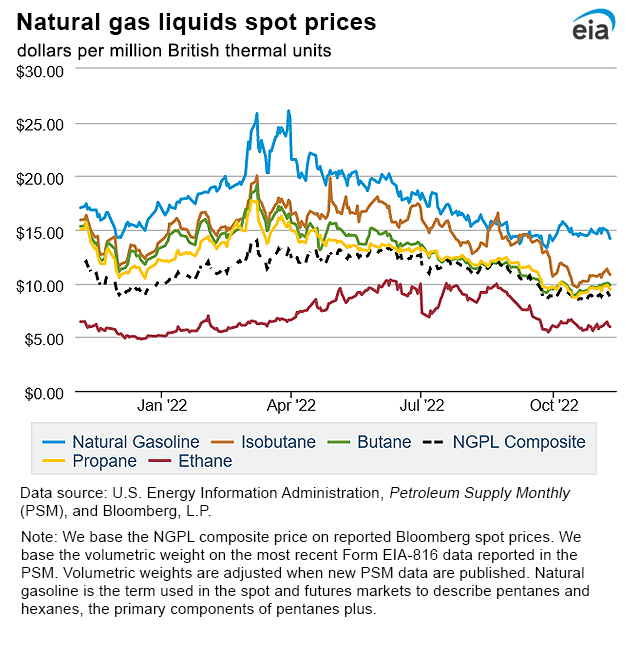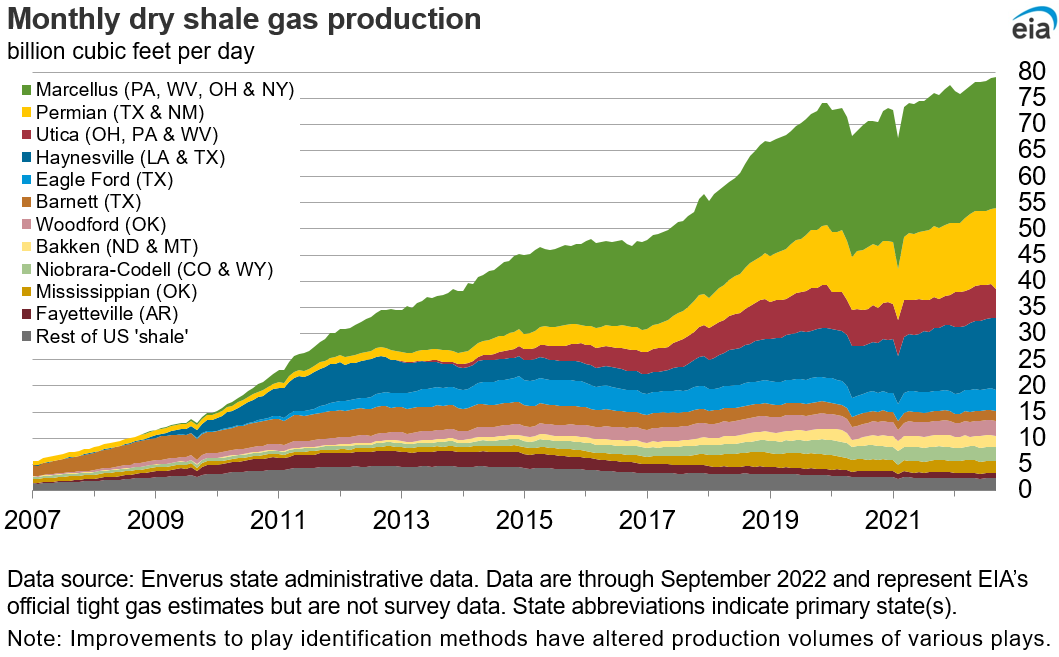In the News:
U.S. working natural gas stocks end refill season below five-year average
Working natural gas in storage in the Lower 48 states as of October 31, 2022, totaled 3,531 billion cubic feet (Bcf), according to month-ending estimates based on EIA’s Weekly Natural Gas Storage Report released November 10. This total is the second-lowest end-of-refill-season inventory level since 2008. Total inventory as of October 31 was 115 Bcf (3%) less than the five-year (2017–21) end-of-October average and 104 Bcf (3%) less than last year at this time.
We estimate that net injections totaled 2,150 Bcf during the 2022 refill season (April 1–October 31). This instance is only the second time since 2016 that net injections exceeded 2,000 Bcf during the refill season. Net injections were 170 Bcf (9%) more than the five-year average injections and 293 Bcf (16%) more than in last year’s refill season.
Injections into underground storage increased during the 2022 refill season as growth in natural gas production exceeded growth in domestic natural gas consumption and exports. Dry natural gas production averaged 97.2 billion cubic feet per day (Bcf/d) during the 2022 refill season compared with 92.5 Bcf/d during the 2021 refill season, an increase of 5% (4.7 Bcf/d), according to data from PointLogic. Natural gas consumption during the 2022 refill season increased by 7% (4.2 Bcf/d) from year-ago levels with every consumption sector posting significant gains over the 2021 refill season. Natural gas consumed for electric power generation increased 7% (2.2 Bcf/d), residential and commercial sector consumption rose 11% (1.2 Bcf/d), and industrial consumption rose 4% (0.7 Bcf/d). Exports rose 4%, with deliveries of natural gas to liquefied natural gas (LNG) facilities increasing 8% (0.9 Bcf/d) and pipeline exports to Mexico declining 5% (0.3 Bcf/d). The fire and resulting shut-in at the Freeport LNG facility in June also likely reduced export activity during the 2022 refill season.
A late surge in injection activity during the final weeks of the refill season turned around what had been a below-average year for storage injections. Working natural gas stocks entered the refill season (April 1) at 285 Bcf below the five-year average. Net injections into working natural gas fell short of the five-year average during most of the weeks that followed. As a result, the deficit to the five-year average grew to 367 Bcf during the week ending August 12, as increased demand for natural gas exceeded gains in natural gas production. However, moderating temperatures since September 9 led to rapid change in the natural gas storage balance, as weekly net injections exceeded the five-year average during seven out of the eight following weeks. The deficit to the five-year average totaled 76 Bcf as of November 4—its lowest level since last January. Although the end of the natural gas storage injection season is traditionally defined as October 31, continued moderating temperatures often lead to further injections in November.
Market Highlights:
(For the week ending Wednesday, November 9, 2022)Prices
- Henry Hub spot price: The Henry Hub spot price fell $1.06 from $4.51 per million British thermal units (MMBtu) last Wednesday to $3.45/MMBtu yesterday, the lowest daily price since December 2021.
- Henry Hub futures prices: The price of the December 2022 NYMEX contract decreased 40.3 cents, from $6.268/MMBtu last Wednesday to $5.865/MMBtu yesterday. The price of the 12-month strip averaging December 2022 through November 2023 futures contracts declined 20.5 cents to $5.146/MMBtu.
- Select regional spot prices: Natural gas spot prices were mixed this report week (Wednesday, November 2, to Wednesday, November 9). Week-over-week price changes at major pricing hubs ranged from a decline of $1.34/MMBtu at Algonquin Citygate to an increase of $1.03/MMBtu at SoCal Citygate.
Prices in the Northeast, including in the Appalachia production region, fell by close to $1.00 or more week over week, which resulted in prices below $3.00/MMBtu at all major hubs in the region on Wednesday. At the Algonquin Citygate, which serves Boston-Area consumers, the price fell $1.34 from $3.66/MMBtu last Wednesday to $2.32/MMBtu yesterday. The last time Algonquin Citygate traded under $3.00/MMBtu prior to this week was in October 2021. At the Transcontinental Pipeline Zone 6 trading point for New York City, the price decreased 96 cents from $3.19/MMBtu last Wednesday to $2.23/MMBtu yesterday. The Tennessee Zone 4 Marcellus spot price decreased $1.04 from $2.92/MMBtu last Wednesday to $1.88/MMBtu yesterday, and the price at Eastern Gas South in southwest Pennsylvania fell $1.15 from $3.03/MMBtu last Wednesday to $1.88/MMBtu yesterday. Temperatures in the Boston Area averaged 58°F this report week, 10°F above normal, leading to 65 fewer heating degree days (HDD) than is normal for this time of year. In the New York-Central Park Area, temperatures averaged 61°F, 10°F above normal, leading to 61 fewer HDDs than normal. And in the Pittsburgh Area, temperatures averaged 57°F, 11°F above normal, which resulted in 74 fewer HDDs than normal.
- At the Chicago Citygate, the price increased 17 cents from $3.48/MMBtu last Wednesday to $3.65/MMBtu yesterday. Net natural gas deliveries into the Midwest from other regions fell by 7% (1.1 billion cubic feet per day [Bcf/d]) this report week, according to data from PointLogic. Kinder Morgan, operator of the Natural Gas Pipeline of America (NGPL), declared a force majeure at Compressor Station 102 in the Midcontinent region. The shutdown of the compressor station constrains natural gas flows northbound through Compressor Station 103 in Ford County, Kansas, effective Tuesday, November 8, until further notice.
- Prices in the West remained elevated this week. The price at Sumas on the Canada-Washington border rose 22 cents from $7.78/MMBtu last Wednesday to $8.00/MMBtu yesterday, while the price at PG&E Citygate in Northern California stayed level at $8.18/MMBtu. The price at SoCal Citygate in Southern California increased $1.03 from $7.39/MMBtu last Wednesday to $8.42/MMBtu yesterday. Lower-than-normal temperatures stretched from the Pacific Northwest to Southern California. In the Seattle City Area, temperatures averaged 44°F this week, 5°F below normal, which resulted in 32 more heating degree days (HDD) than normal. Temperatures in the Riverside Area, inland from Los Angeles, averaged 57°F this week, which resulted in 51 HDDs, 29 more than normal. Consumption of natural gas in all sectors in the Western region rose week over week by 13% (1.2 Bcf/d), led by a 39% (1.3 Bcf/d) increase in the residential and commercial sectors, according to data from PointLogic.
- International futures prices: International natural gas futures prices decreased this report week. According to Bloomberg Finance, L.P., weekly average futures prices for LNG cargoes in East Asia decreased $1.06 to a weekly average of $27.91/MMBtu, and natural gas futures for delivery at the Title Transfer Facility (TTF) in the Netherlands, the most liquid natural gas market in Europe, decreased less than 2 cents to a weekly average of $33.95/MMBtu.
- Natural gas plant liquids (NGPL) prices: The natural gas plant liquids composite price at Mont Belvieu, Texas, rose by 9 cents/MMBtu, averaging $8.97/MMBtu for the week ending November 9. Ethane prices rose by the highest percentage, with the weekly average price increasing 4% despite natural gas prices at the Houston Ship Channel falling by 34% week over week. The fractionation spread (the premium for ethane over natural gas) rose by 58%. Ethylene spot prices kept pace with ethane, also rising 4% week over week. Propane prices remained relatively unchanged, while the weekly average price of crude oil rose 1%, resulting in a 1% increase in the propane discount relative to crude oil. Normal butane prices and isobutane prices both rose 2%. Despite the increase in crude oil prices, natural gasoline prices, which generally follow crude oil, fell 1%.
Pipeline maintenance also contributed to the week-over-week decline in prices. Texas Eastern Transmission, LP (TE) identified a pipeline condition that required a pipe replacement on its Line 73 (Notice 127056) between the Salineville compressor station in Columbiana County, Ohio, and the Colerain compressor station in Jefferson County, Ohio. As a result of this remediation, capacity through the Salineville compressor station has been reduced to zero, restricting westbound natural gas flows out of the region. TE anticipates this work will continue through November 18.
Daily spot prices by region are available on the EIA website.
Supply and Demand
- Supply: According to data from PointLogic, the average total supply of natural gas fell by 1.5% (1.6 Bcf/d) compared with the previous report week. Dry natural gas production decreased by 0.6% (0.6 Bcf/d), and average net imports from Canada decreased by 21.5% (1.1 Bcf/d) from last week.
- Demand: Total U.S. consumption of natural gas rose by 2.0% (1.4 Bcf/d) compared with the previous report week, according to data from PointLogic. Natural gas consumed for power generation climbed by 4.0% (1.2 Bcf/d) week over week. Industrial sector consumption decreased by 0.5% (0.1 Bcf/d) week over week, and in the residential and commercial sectors, consumption increased by 1.7% (0.3 Bcf/d). Natural gas exports to Mexico increased 2.3% (0.1 Bcf/d). Natural gas deliveries to U.S. LNG export facilities (LNG pipeline receipts) averaged 11.5 Bcf/d, or 0.4 Bcf/d lower than last week.
Liquefied Natural Gas (LNG)
- Pipeline receipts: Overall natural gas deliveries to U.S. LNG export terminals decreased by 0.4 Bcf/d week over week to average 11.5 Bcf/d this report week, according to data from PointLogic. Natural gas deliveries to LNG export terminals in South Louisiana decreased by 0.5 Bcf/d to 8.0 Bcf/d, while natural gas deliveries to other LNG terminals averaged a combined 3.5 Bcf/d.
- Vessels departing U.S. ports: Twenty-one LNG vessels (eight from Sabine Pass, four each from Cameron and Corpus Christi, three from Calcasieu Pass, and one each from Cove Point and Elba Island) with a combined LNG-carrying capacity of 78 Bcf departed the United States between November 3 and November 9, according to shipping data provided by Bloomberg Finance, L.P.
Rig Count
- According to Baker Hughes, for the week ending Tuesday, November 1, the natural gas rig count decreased by 1 rig from a week ago to 155 rigs, as the Haynesville dropped 1 rig. The number of oil-directed rigs increased by 3 rigs from a week ago to 613 rigs. The Ardmore Woodford added one rig, and the Williston added two rigs. The total rig count, which includes 2 miscellaneous rigs, now stands at 770 rigs, which is 220 more rigs than the same week last year.
Storage
- The net injections into storage totaled 79 Bcf for the week ending November 4, compared with the five-year (2017–2021) average net injections of 20 Bcf and last year's net injections of 15 Bcf during the same week. Working natural gas stocks totaled 3,580 Bcf, which is 76 Bcf (2%) lower than the five-year average and 37 Bcf (1%) lower than last year at this time.
- According to The Desk survey of natural gas analysts, estimates of the weekly net change to working natural gas stocks ranged from net injections of 66 Bcf to 101 Bcf, with a median estimate of 80 Bcf.
See also:
Top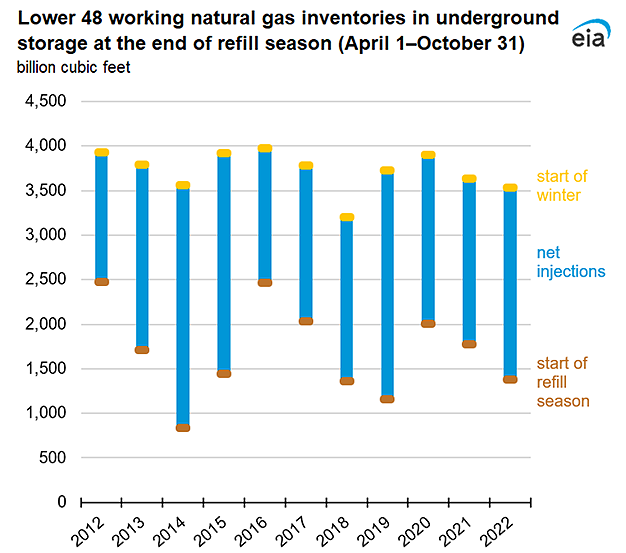
Data source: U.S. Energy Information Administration, Natural Gas Monthly and Weekly Natural Gas Storage Report
Note: The data point for October 31, 2020, is an interpolated value, based on the Weekly Natural Gas Storage Report.
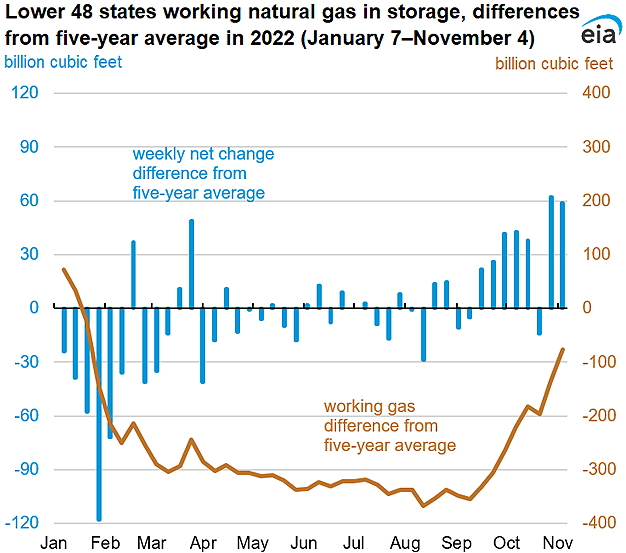
Data source: U.S. Energy Information Administration, Weekly Natural Gas Storage Report
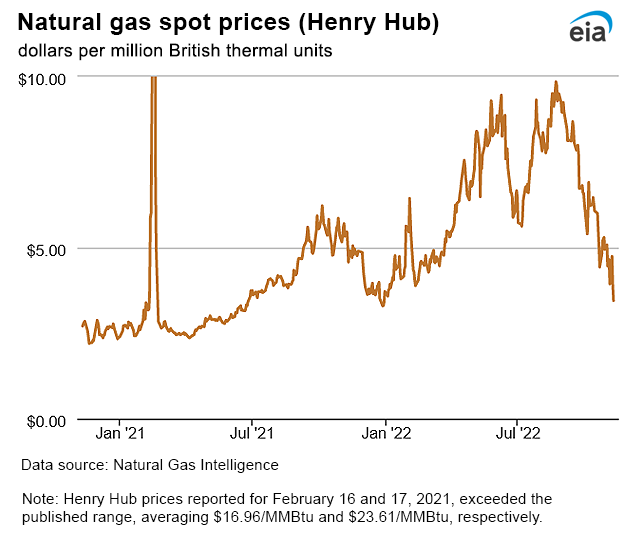
| Spot Prices ($/MMBtu) | Thu, 03-Nov |
Fri, 04-Nov |
Mon, 07-Nov |
Tue, 08-Nov |
Wed, 09-Nov |
|---|---|---|---|---|---|
| Henry Hub |
4.65 |
3.94 |
4.75 |
3.90 |
3.45 |
| New York |
2.01 |
0.76 |
3.34 |
3.18 |
2.23 |
| Chicago |
3.33 |
1.62 |
3.31 |
3.53 |
3.65 |
| Cal. Comp. Avg.* |
7.25 |
7.40 |
8.73 |
7.68 |
7.89 |
| Futures ($/MMBtu) | |||||
| December contract | 5.975 |
6.400 |
6.944 |
6.138 |
5.865 |
| January contract |
6.330 |
6.754 |
7.244 |
6.524 |
6.225 |
| Data source: Natural Gas Intelligence and CME Group as compiled by Bloomberg, L.P. *Avg. of NGI's reported prices for: Malin, PG&E Citygate, and Southern California Border Avg. |
|||||
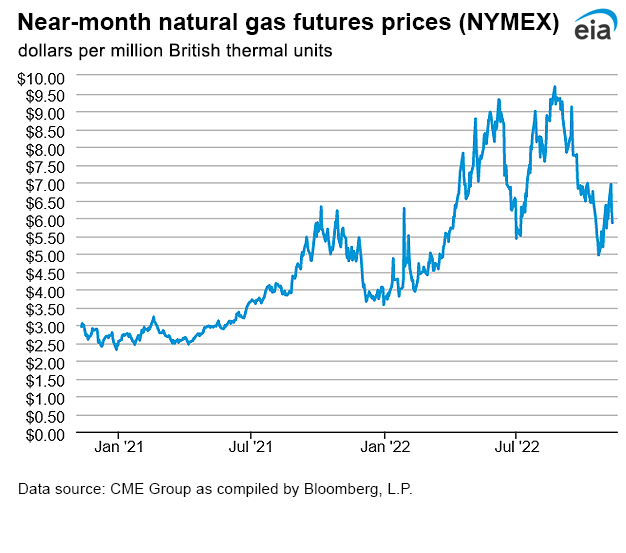
| U.S. natural gas supply - Gas Week: (11/3/22 - 11/9/22) | |||
|---|---|---|---|
Average daily values (billion cubic feet) |
|||
this week |
last week |
last year |
|
| Marketed production | 112.5 |
113.0 |
108.4 |
| Dry production | 99.9 |
100.5 |
97.2 |
| Net Canada imports | 3.9 |
5.0 |
5.5 |
| LNG pipeline deliveries | 0.1 |
0.1 |
0.1 |
| Total supply | 103.9 |
105.5 |
102.7 |
|
Data source: PointLogic | |||
| U.S. natural gas consumption - Gas Week: (11/3/22 - 11/9/22) | |||
|---|---|---|---|
Average daily values (billion cubic feet) |
|||
this week |
last week |
last year |
|
| U.S. consumption | 72.2 |
70.9 |
79.1 |
| Power | 30.3 |
29.1 |
30.7 |
| Industrial | 23.0 |
23.2 |
23.9 |
| Residential/commercial | 18.9 |
18.6 |
24.6 |
| Mexico exports | 5.8 |
5.7 |
5.5 |
| Pipeline fuel use/losses | 6.8 |
6.7 |
6.9 |
| LNG pipeline receipts | 11.5 |
11.9 |
11.0 |
| Total demand | 96.4 |
95.2 |
102.5 |
|
Data source: PointLogic | |||
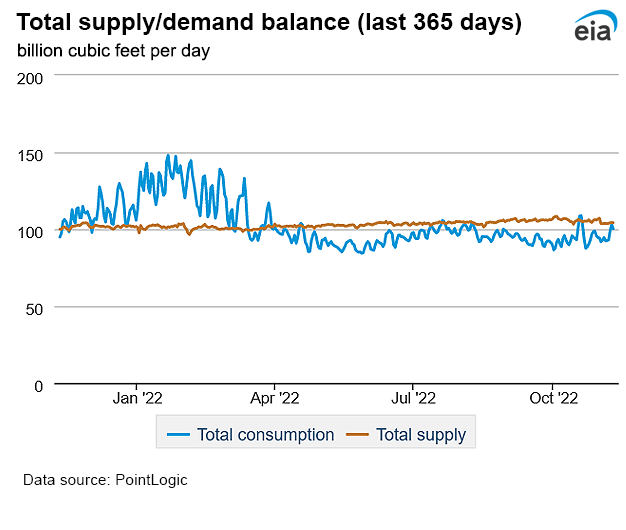
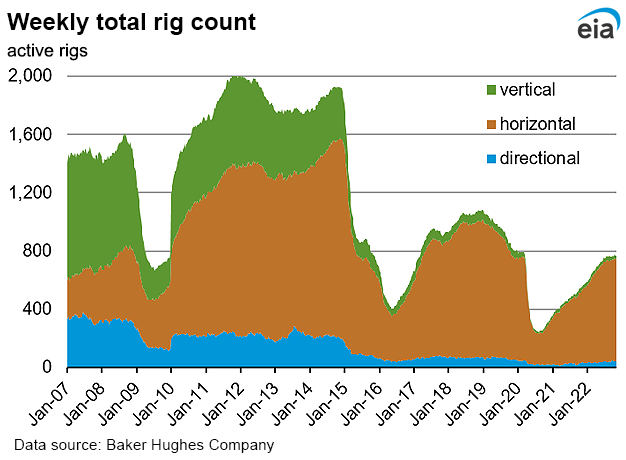
| Rigs | |||
|---|---|---|---|
Tue, November 01, 2022 |
Change from |
||
last week |
last year |
||
| Oil rigs | 613 |
0.5% |
36.2% |
| Natural gas rigs | 155 |
-0.6% |
55.0% |
| Note: Excludes any miscellaneous rigs | |||
| Rig numbers by type | |||
|---|---|---|---|
Tue, November 01, 2022 |
Change from |
||
last week |
last year |
||
| Vertical | 22 |
0.0% |
-12.0% |
| Horizontal | 705 |
0.3% |
43.3% |
| Directional | 43 |
0.0% |
30.3% |
| Data source: Baker Hughes Company | |||
| Working gas in underground storage | ||||
|---|---|---|---|---|
Stocks billion cubic feet (Bcf) |
||||
| Region | 2022-11-04 |
2022-10-28 |
change |
|
| East | 865 |
848 |
17 |
|
| Midwest | 1,068 |
1,042 |
26 |
|
| Mountain | 208 |
204 |
4 |
|
| Pacific | 247 |
247 |
0 |
|
| South Central | 1,193 |
1,160 |
33 |
|
| Total | 3,580 |
3,501 |
79 |
|
| Data source: U.S. Energy Information Administration Form EIA-912, Weekly Underground Natural Gas Storage Report | ||||
| Working gas in underground storage | |||||
|---|---|---|---|---|---|
Historical comparisons |
|||||
Year ago (11/4/21) |
5-year average (2017-2021) |
||||
| Region | Stocks (Bcf) |
% change |
Stocks (Bcf) |
% change |
|
| East | 897 |
-3.6 |
906 |
-4.5 |
|
| Midwest | 1,074 |
-0.6 |
1,080 |
-1.1 |
|
| Mountain | 213 |
-2.3 |
213 |
-2.3 |
|
| Pacific | 258 |
-4.3 |
290 |
-14.8 |
|
| South Central | 1,175 |
1.5 |
1,166 |
2.3 |
|
| Total | 3,617 |
-1.0 |
3,656 |
-2.1 |
|
| Data source: U.S. Energy Information Administration Form EIA-912, Weekly Underground Natural Gas Storage Report | |||||
| Temperature – heating & cooling degree days (week ending Nov 03) | ||||||||
|---|---|---|---|---|---|---|---|---|
HDDs |
CDDs |
|||||||
| Region | Current total |
Deviation from normal |
Deviation from last year |
Current total |
Deviation from normal |
Deviation from last year |
||
| New England | 102 |
-29 |
-10 |
0 |
0 |
0 |
||
| Middle Atlantic | 91 |
-31 |
-12 |
0 |
0 |
0 |
||
| E N Central | 91 |
-44 |
-38 |
0 |
0 |
0 |
||
| W N Central | 84 |
-58 |
-67 |
0 |
0 |
0 |
||
| South Atlantic | 52 |
-23 |
-20 |
24 |
7 |
9 |
||
| E S Central | 42 |
-34 |
-43 |
0 |
-3 |
0 |
||
| W S Central | 34 |
-7 |
-14 |
14 |
-1 |
5 |
||
| Mountain | 134 |
4 |
28 |
0 |
-4 |
-6 |
||
| Pacific | 71 |
12 |
31 |
0 |
-2 |
-1 |
||
| United States | 79 |
-23 |
-15 |
6 |
0 |
2 |
||
|
Data source: National Oceanic and Atmospheric Administration Note: HDDs=heating degree days; CDDs=cooling degree days | ||||||||
Average temperature (°F)
7-day mean ending Nov 03, 2022
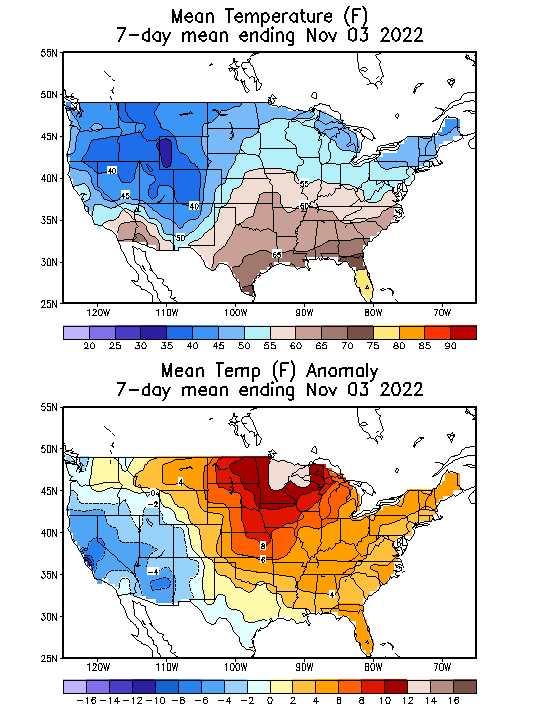
Data source: National Oceanic and Atmospheric Administration
Deviation between average and normal temperature (°F)
7-day mean ending Nov 03, 2022

Data source: National Oceanic and Atmospheric Administration

